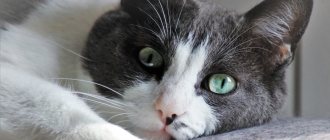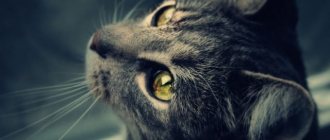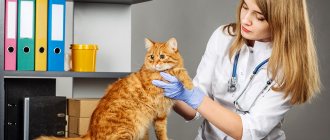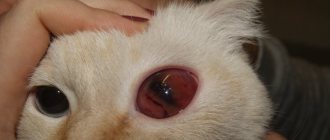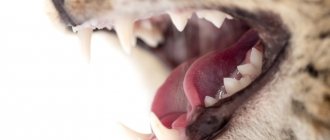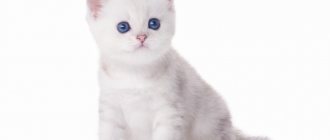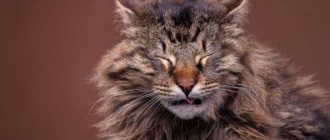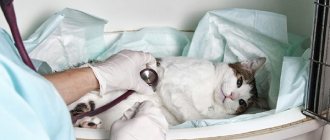The situation when stray and “semi-domesticated” cats’ eyes do not shine with health is common. Keratitis and conjunctivitis, injuries and parasites - all this leads to the fact that they are covered with a crust of dried exudate. If the animal is always at home, it is not immune from eye problems. A clear confirmation of this is the turn of the century. In cats, this pathology is diagnosed much less often than in the case of dogs, but this also happens.
What is a turn of the century?
By entropion, veterinarians mean the folding of skin folds inside the eye, which occurs as a result of weakening of the corresponding muscles. This condition is dangerous for the health of the pet, primarily because, along with the eyelid, the hair and eyelashes also change their position, which now come into contact with the cornea of the eye, which is fraught with inflammation.
Entropion of the lower eyelid in a Maine Coon
Volvulus can be expressed to a greater or lesser extent. A mild form of bloat causes periodic but minor discomfort in the cat. The owner may not notice its symptoms at all, since the main manifestation of a mild form is lacrimation. A severe form of entropion of the eyelid sometimes ends in the animal’s blindness if medical assistance is not provided in time.
By the way! It is believed that entropion of the lower eyelid is observed in cats much more often than entropion of the upper eyelid.
Breed influence
It is believed that entropion in cats is largely determined by their breed. Moreover, there are breeds that experience this illness most difficultly and rarely fully recover from it (such as Sphynxes).
Brachycephalic breeds are predisposed to developing entropion
In a physiological sense, cats with brachycephaly are most susceptible to entropion. Among brachycephalic breeds the following breeds are listed:
- Himalayan;
- Persian;
- Scottish;
- Exotic;
- British.
The peculiarity of brachycephals lies in the specific structure of their skull, which gives the impression that the muzzles of representatives of these breeds are slightly flattened. More specifically, the specific physiology of brachycephals is as follows:
- narrowed nostrils;
- elongated soft palate;
- narrowed trachea, as a result of which cats may experience periodic swelling of the soft tissues.
Comparison of the skulls of an ordinary cat and a brachycephalic cat
Owners of brachycephalics need to especially carefully monitor not only the breathing of their pets, but also the condition of the eyes, knowing the weaknesses of the breed.
Volvulus is also typical for Maine Coons, however, these large cats often exhibit milder forms. At the same time, in representatives of the breed, after a cured entropion, eyelashes still sometimes grow ingrown into the eyelid or into the cornea itself.
Video - Maine Coon's turn of the century
Diseases of the eyes and protective devices of the visual organs
Bruises and mechanical damage without compromising the integrity of the skin.
Cause. They occur in a cat as a result of a blow with a blunt object or as a result of mechanical damage (bumping into blunt objects, falling).
Clinical signs. During a clinical examination, the veterinarian notes the presence of bruises and hematomas in the eye area. In the area of injury, upon palpation, an increase in local temperature is noted, and a change in the size of the eyeball occurs.
Treatment. A cat with an eye injury should be taken to a veterinary clinic. To relieve pain in a sick animal, a 2% solution of novocaine, antimicrobial drops or eye ointment is instilled into the conjunctival sac. If there is a hematoma, it is necessary to apply cold to the hematoma (only on the eyelid area, not on the eyeball). If there are serious complications, it is sometimes necessary to resort to surgery.
Types of entropion
There are two types of entropion depending on the causes of its occurrence:
- primary entropion: is hereditary and is usually found in kittens (before they reach six months of age). It appears due to breed predisposition or improper formation of the fetus. Surgery is prescribed as treatment, however, sometimes primary volvulus goes away without medical help;
Entropion of the eyelid can affect both an adult and a kitten
- secondary entropion of the eyelid: explained by exogenous causes that have nothing to do with the physiology of the cat: various injuries, bruises, unsuccessful operations, etc. A common cause of secondary entropion is also untreated eye diseases, which lead to relapse even after medical correction of the eyelid.
Before selecting the correct treatment regimen, the veterinarian will certainly determine what type of entropion in a particular cat is. Primary and secondary types differ significantly in terms of treatment methods, however, both of them usually involve surgery.
Before making a diagnosis, the doctor carefully examines the cat and prescribes a series of tests.
Iritis (iridocyclitis)
Iritis (iridocyclitis) is inflammation of the iris and ciliary body.
Cause. Traumatic injury, inflammation spreading from the cornea, complications after eye surgery, infectious diseases.
Clinic. During a clinical examination, a clinic veterinarian notes a constriction of the pupil, dimming of the iris, photophobia, pain, and cloudy fluid in the anterior chamber of a sick cat. When conjunctivitis is associated with the disease, we note serous-purulent discharge.
Treatment. In order to restore pupil contraction, a 1% atropine solution, novocaine blockade, and antibiotics are prescribed. During treatment, eye drops and ointments with anti-inflammatory and antimicrobial effects have a good effect.
Symptoms
As already mentioned, entropion of the eyelid can occur in different forms and be either obvious to the owner or hidden. Among the symptoms characteristic of entropion, we list the main ones:
- redness of the eyes, as well as their shine due to lacrimation;
- increased tearfulness;
- moistening and sticking of fur around the eyes;
- change in the shape of the eyes - the eyes become smaller and visually narrower;
- inflammation and swelling of the eyelids/eyelids;
- accumulation of pus in the inner corners of the animal’s eyes;
- redness of the conjunctiva;
- photophobia;
- periodic “wink”;
- Corneal ulcer – typical for severe disease.
One of the sure signs of entropion is avoidance of bright light.
Many inexperienced owners may confuse a mild form of volvulus with conjunctivitis due to the characteristic purulent discharge and try to treat it at home, which will not bring any results and can even be dangerous.
Important! Persians may have the most difficulty experiencing entropion, as this disease may be accompanied by corneal necrosis, leading to serious consequences.
When the eyelid is turned up, the animal sometimes tries to “correct” it with the help of its paws, which should under no circumstances be allowed. A cat runs the risk of introducing bacteria into an inflamed eye, which will further aggravate the course of the disease. In addition, scratching will not relieve your pet of pain, but will only exaggerate it.
Scratching your eyes only makes your cat's condition worse.
Wounds and open injuries to the eye.
Cause. Most eye injuries and wounds in cats occur as a result of fights with their fellow cats, falling on sharp objects, or strong blows leading to damage to the skin.
Clinical signs. During a clinical examination, the veterinarian notes a violation of the skin in the area of the injured eye, the presence of scratches, wounds, and bleeding from the injured areas.
Treatment. The damaged area is washed with hydrogen peroxide, bleeding is stopped; in the presence of large wounds, pain relief and suturing are used, and antimicrobial therapy is administered locally. For complex and large eye injuries, eye microsurgery and sometimes removal of the damaged eye are performed.
Diagnostics
If the owner wants to help his cat, then the main thing that is required of him is a trip with the animal to the veterinarian. Any eye washing will not contribute to recovery at all, but can worsen the overall picture. As a rule, the veterinarian quickly makes a diagnosis, since entropion of the eyelid can be visible to the naked eye.
However, to clarify the diagnosis and determine the general health of the animal, the specialist prescribes some related tests:
- general and biochemical blood test;
- Analysis of urine;
- Ultrasound of the abdominal organs;
- electrocardiogram (ECG).
All tests listed by the veterinarian must be taken without fail.
Specifics of analyzes
Owners are often surprised by such a large list of “unnecessary” tests and refuse many of them, since “they have nothing to do with the eyes.” In doing so, they are making a serious mistake. The results of a general examination are important to the veterinarian because entropion itself can be a symptom of some more global, but not yet identified, pathology that suppresses the pet’s immunity. In this regard, in some cases, the cat owner may also be offered a urine test for bacterial culture and even instillation of a special fluorescent agent into the eyes.
When turning the eyelid, it is important for the veterinarian to see the overall picture of the pet’s health
Do not be afraid of such unusual research methods. They are not cheap, but they can guarantee that after eyelid correction it will not sag after a few days or months. In addition, in some cases, during the research process, specialists find the desired pathology in a completely different area (for example, an infectious disease in a latent chronic form). And the animal is cured without surgery. Therefore, you should never rush to put a cat under a scalpel without undergoing a detailed examination.
Symptoms
How can you tell if your pet needs an urgent visit to the vet? In the initial stages, the cat often begins to “wink” at the owner and avoids looking at light sources. Tears flow profusely from her eyes, and soon the discharge becomes mucous and quite thick. The animal acquires the habit of looking sideways at the world around it. In many cases, the eyelids themselves become inflamed and swollen, and the tissues of the organ become noticeably hot to the touch.
Intolerance to light reaches a peak stage; the animal cannot look at lamps or the sun at all. It begins to constantly rub its eyes with its paws, and this causes it severe pain. If you notice these symptoms in your pet, we advise you to contact your veterinarian immediately.
Operation
Despite some cases of non-surgical treatment of pets, surgery is the only solution in the vast majority of cases. The essence of this operation is that the surgeon carefully returns the bent piece of the eyelid to the correct position and secures it with special sutures that will not leave scars on the cat’s face.
Sutures placed on the eyelid during surgery are subsequently removed by a veterinarian
Usually the operation is performed in one go, but if the situation is especially severe, then moving and securing the eyelid can be carried out in several interventions, the number of which is determined by the surgeon after examination.
Preparing for surgery
Any surgical intervention, regardless of its complexity, requires anesthesia, which obliges the owner to follow several strict rules when preparing the pet for surgery. Among these rules are:
- Any food is excluded from the animal’s diet 12 hours (and preferably even 24 hours) before surgery. At the same time, the cat must maintain access to water;
- if the disease is at a severe stage, the damaged cornea of the eye is covered with a third eyelid, which acts as a protective layer;
- the animal's eyes (or eyes) are lubricated with tetracycline ointment and prescribed antiseptic drops are placed. Note that this point does not always take place - it is determined by the veterinarian.
Often, before surgery, the cat is prescribed special antibacterial drops.
Important! Since the cat will be under anesthesia during the operation, it is necessary to first deworm the animal, if possible. Otherwise, the worms may block the animal’s access to oxygen directly during surgery.
After operation
Perhaps the most important question for the owner of a sick pet is what are the cat's chances of making a full recovery? Fortunately, with entropion of the eyelid, the prognosis is very favorable - final cure is achieved in 90 to 95% of animals.
A cat undergoing eyelid inversion surgery
The effectiveness of the operation is influenced by the following factors:
- the cat's health status before surgery - the better the cat feels before surgery, the faster it comes to its senses after its completion;
- age of the pet - young animals tolerate anesthesia and recover on average faster than their more mature relatives;
- breed - as already noted, recovery is the hardest for sphinxes, but there are exceptions;
- the presence of other diseases that weaken the animal’s immunity.
Condition of the animal's eyelid before and after surgery
It should be remembered that the surgeon is not a magician. And even the most successful operation will not be able to bring the cat’s well-being back to normal if it is not taken care of appropriately at home. To help the pet recover completely, the owner must take the following simple steps:
- Put a protective collar on the cat that will not allow him to interact with the eye area. Of course, not every pet will be happy with such an accessory, but this collar is a temporary necessity;
- In the first days, carefully monitor any movements of the pet and do not let him make difficult jumps;
- instill antibiotics in the eyes in the form of drops - this will prevent any development of infection after surgery;
- treat the cat's stitches. The pet owner will learn more about what antiseptic agents are used for treatment and how exactly it is carried out from the attending physician.
You can read below about how to drip or lubricate a cat’s eyes with ointment with minimal damage to yourself and your pet.
How to treat a cat's eyes
In some situations, cats that react violently to anesthesia require sedatives that reduce affect and balance the pets.
Sutures are removed one and a half to two weeks after the operation. It is then that the veterinarian evaluates the final results and draws conclusions about further maintenance therapy.
A protective collar will prevent your pet from introducing infection into the operated eyelids
Developmental defects
Hairless sphinxes were specially bred through inbreeding in order to consolidate the mutation of “rubbery” smooth skin and an abundance of folds. As a result, animals were prone to abnormal development of a number of organs: eyes, jaws, spine, intestines.
Another name is “carp bite.” A congenital pathology of smooth-haired pets, manifested by shortening of the lower jaw. Its growth stops prematurely due to early ossification of the symphysis in the incisor area.
The disease is manifested by the following symptoms:
- the rows of incisors do not align or touch;
- distortions of the jaw, narrowing of the arch;
- asymmetry of the dentition;
- tongue hypoplasia;
- on the hard palate there are ulcers and inflammations from dental injuries.
With mild manifestations, sphinxes adapt and can eat solid pieces of food.
Microphthalmos
Improper formation and development of the eye leads to a decrease in its size. Accompanied by decreased visual acuity, keratitis, coloboma and cataracts.
This disease can be detected in kittens at birth. They are born with open eyes, tumors and eye cysts. One of the causes of the anomaly is intrauterine chlamydia.
Scientists have proven the connection of the disease with reduced fertility of small animals.
Externally, the pathology looks like an inward turning of the eyelids. The eyelashes and the edge of the eyelids curl up and touch the membrane of the eye. As a result, animals from birth suffer from continuous conjunctivitis and inflammation of the sclera. Surgeons perform surgical interventions for correction, as a result of which minor improvements are possible.
The defect often occurs in kittens born after inbred crossing. Every second litter is characterized by such a congenital disease. Animals often turn out to be non-viable, since additional serious defects are simultaneously detected in them:
- anomaly of the intestine, mainly the thick section;
- weak rectal sphincter;
- reduced height;
- underdevelopment of the thoracic and lumbar vertebrae.
READ African swine fever (ASF) - signs, symptoms and prevention
Nipple hyperplasia
It is inherited through the female line. Scientists have proven the connection with the characteristic color and eye color.
The following animals are mainly affected:
- with light blue skin;
- blue-cream;
- with blue eyes.
The disease manifests itself and progresses gradually. When female kittens turn one year old, their nipples turn red. Over time, the skin around the nipple thickens and becomes keratinized. The nipple itself takes the shape of a club and increases in size. Cysts often appear.
In such mother cats, babies are often born with pathologies of internal organs and die at an early age due to the incompatibility of severe defects with life. The birth itself is difficult due to the weakness of labor. Little milk is produced.
One of the proven causes of hyperplasia is taking medications that suppress sexual activity. At the same time, unilateral or bilateral ovarian cysts form. Surgical treatment: sterilization, nipple removal.
Underdevelopment of the thymus
Kitten falling asleep syndrome is also called pathological underdevelopment of the thymus. Outwardly healthy kittens, who had just eaten or played, begin to die one by one - they literally fall asleep.
The most common cause of mass death of kittens of the same litter is inbreeding. Babies have a very low survival rate. Already in the first days, some people clearly notice the following signs:
- bluish skin on the face and paws;
- growth retardation;
- parchment leather;
- weak, sluggish sucking.
Gingival hyperplasia
Accompanied by pathological growth of mucous tissue, up to the closure of the surface of the teeth. It manifests itself as increased bleeding, pain, and a high risk of bleeding when eating solid food or cartilage. Does not affect other structures of the oral cavity (tongue, cheeks). It occurs chronically.
Video “Overview of Sphinx Diseases”
Hairless cats, unlike other breeds, have the most vulnerable spot – their skin. Lesions are possible in both kittens and adult cats. Hormonal factors play a significant role, especially adrenocorticotropic hormone (ACTH), corticosteroids, and androgens. Bacterial and fungal pathogens often penetrate unprotected skin, and serious vascular damage is possible.
Rashes appear in young individuals of both sexes during rapid puberty. The localization of the rash most often occurs on the face, neck, back, tail, and stomach. Cream and blue cats are most often affected.
READ Antigadin for cats
Acne is divided into 2 types:
- comedones. Inflammation is mild. They are well treated with salicylic acid, “Zinerit”;
- angular cystic rash. Severe form with the formation of deep infiltrates and cavities filled with pus. They often merge, break into fistulas, and heal with scars. Doxycycline and Minocycline are used for treatment.
Dermatitis
Occurs mainly seasonally. More often in Sphynx girls after estrus. Accompanied by itching, scratching, secondary infection, and the formation of large eczematoid areas.
Vasculitis
Experts have proven the connection between vascular pathology and the color of cats (cream, reddish color). The disease is characterized by inflammation of the walls of blood vessels; the process can involve vessels of various types in all organs.
| Infectious | Medication |
| mushrooms | B vitamins |
| viruses | dyes |
| mycoplasma | antibiotics |
| staphylococci | sulfonamides |
| streptococci |
There are several types of vasculitis, which have characteristic manifestations.
| Forms | Typical signs |
| Telangiectatic | Sudden appearance of pink or reddish spots |
| Localization: back, abdomen, lateral surfaces | |
| Peripheral growth, tendency to merge | |
| Livedo | A mesh pattern forms on the back and back of the head |
| Characterized by small nodules, hemorrhages, bluish spots | |
| Necrotic ulcers and blisters with brown exudate appear | |
| Eczematoid | Spots, hyperemia on hind legs and tail |
| Papulovesicles and crusts form | |
| Severe itching, possible infection | |
| Polymorphic | Manifested by symptoms of the above forms |
| May change from one type to another or combine symptoms |
